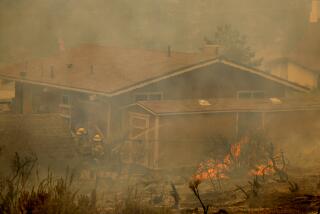San Diego burns with pride as beach fire pit funding is restored
Reporting from San Diego — Most cities have a certain something that brings a glow to the civic heart.
In San Diego, much of that glow comes from inside 186 concrete rectangles that weigh 1,954 pounds apiece and are scattered from La Jolla to Ocean Beach.
Beach fire pits are important to San Diego’s self-burnished image as America’s Finest City and to its $17-billion-a-year tourism industry.
Two years ago when the cash-strapped city started to remove the pits as too expensive to maintain, the embers hit the fan. Mayor Jerry Sanders and other politicians immediately launched an aggressive search for a fire pit philanthropist.
Soon an unnamed donor pledged enough cash to keep the pits in place for 18 months. The name of that civic benefactor remains a closely held secret. Other donors were found once that money was burned up.
Now the city budget is showing some signs of recovery. After several years of cutting services and hardball contract negotiations with city employees, the city is projecting a $16.5-million surplus for the next fiscal year.
With the unexpected windfall, Sanders announced that his budget will include restoring some operating hours at 35 branch libraries and 55 recreation sites. Also, 15 cadets will be added to the next police academy class, and a new dispatch system is being purchased for the city’s 47 fire stations.
But none of those civic strides came with the same hoopla as an announcement from Sanders and two City Council members from beachfront districts that, for the first time in three years, the city can afford to pay for the maintenance of its beach fire pits without resorting to corporate sponsorship or anonymous donors.
“These fire pits are a hallmark of San Diego’s culture and community,” Sanders said last week at a news conference timed for maximum TV coverage. “This city is turning the corner.”
Fire pits of various shapes and construction have been on the beach in San Diego since at least the 1940s, when the city was burgeoning with sailors, Marines and aircraft-factory workers. The number of pits has fluctuated over the years, but their importance has never been challenged.
“In San Diego, fire pits at the beach are iconic,” said Stacey LoMedico, director of the Park and Recreation Department. “The fire pits remind us that the weather is so good that we can enjoy the outdoors late into the evening.”
The annual maintenance is put at $120,500.
Two city workers clean the fire pits, once a week in the summer, once every two weeks in the winter. The sand, ashes, and embers are scraped away and hauled off. Each pit takes about 30 minutes to clean, plus driving time.
The city went to the rectangular shape after several incidents in the 1970s when beach-goers rolled the round ones down the beach. In the early 1980s, maintenance of the fire pits took on added significance when the granddaughter of a City Council member burned her foot.
Notwithstanding the festive mood about fire pit funding, city services still show the effects of years of budget cutting.
The Police Department’s horse patrol, a presence for decades at Balboa Park, has been disbanded. There are no supervisors at some of the city’s skateboard parks. And the city cannot afford to buy fertilizer for the lawns at its parks.
Pictures of happy families enjoying bonfires on the beach at San Diego are a common theme in the print and broadcast advertising of the local tourist bureau to lure vacationers to spend time and money in San Diego.
“Fire pits are absolutely critical for us,” said Joe Terzi, president and chief executive officer of the San Diego Convention and Visitors Bureau. “Fire pits are cool.”
More to Read
Sign up for Essential California
The most important California stories and recommendations in your inbox every morning.
You may occasionally receive promotional content from the Los Angeles Times.










